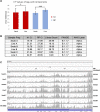Sequencing SARS-CoV-2 from antigen tests
- PMID: 35134077
- PMCID: PMC8824375
- DOI: 10.1371/journal.pone.0263794
Sequencing SARS-CoV-2 from antigen tests
Abstract
Genomic surveillance empowers agile responses to SARS-CoV-2 by enabling scientists and public health analysts to issue recommendations aimed at slowing transmission, prioritizing contact tracing, and building a robust genomic sequencing surveillance strategy. Since the start of the pandemic, real time RT-PCR diagnostic testing from upper respiratory specimens, such as nasopharyngeal (NP) swabs, has been the standard. Moreover, respiratory samples in viral transport media are the ideal specimen for SARS-CoV-2 whole-genome sequencing (WGS). In early 2021, many clinicians transitioned to antigen-based SARS-CoV-2 detection tests, which use anterior nasal swabs for SARS-CoV-2 antigen detection. Despite this shift in testing methods, the need for whole-genome sequence surveillance remains. Thus, we developed a workflow for whole-genome sequencing with antigen test-derived swabs as an input rather than nasopharyngeal swabs. In this study, we use excess clinical specimens processed using the BinaxNOW™ COVID-19 Ag Card. We demonstrate that whole-genome sequencing from antigen tests is feasible and yields similar results from RT-PCR-based assays utilizing a swab in viral transport media.
Conflict of interest statement
The authors have declared that no competing interests exist.
Figures


Similar articles
-
Clinical evaluation of a multiplex real-time RT-PCR assay for detection of SARS-CoV-2 in individual and pooled upper respiratory tract samples.Arch Virol. 2021 Sep;166(9):2551-2561. doi: 10.1007/s00705-021-05148-1. Epub 2021 Jul 14. Arch Virol. 2021. PMID: 34259914 Free PMC article.
-
Performance of anterior nares and tongue swabs for nucleic acid, Nucleocapsid, and Spike antigen testing for detecting SARS-CoV-2 against nasopharyngeal PCR and viral culture.Int J Infect Dis. 2022 Apr;117:287-294. doi: 10.1016/j.ijid.2022.02.009. Epub 2022 Feb 9. Int J Infect Dis. 2022. PMID: 35149246 Free PMC article.
-
A Multiplex One-Step RT-qPCR Protocol to Detect SARS-CoV-2 in NP/OP Swabs and Saliva.Curr Protoc. 2021 May;1(5):e145. doi: 10.1002/cpz1.145. Curr Protoc. 2021. PMID: 34004070 Free PMC article.
-
Tools and Techniques for Severe Acute Respiratory Syndrome Coronavirus 2 (SARS-CoV-2)/COVID-19 Detection.Clin Microbiol Rev. 2021 May 12;34(3):e00228-20. doi: 10.1128/CMR.00228-20. Print 2021 Jun 16. Clin Microbiol Rev. 2021. PMID: 33980687 Free PMC article. Review.
-
Value of anal swabs for SARS-COV-2 detection: a literature review.Int J Med Sci. 2021 Apr 16;18(11):2389-2393. doi: 10.7150/ijms.59382. eCollection 2021. Int J Med Sci. 2021. PMID: 33967616 Free PMC article. Review.
Cited by
-
Opportunities for Enhanced Public Health Surveillance via Molecular Detection and Sequencing of Diverse Respiratory Viruses From Self-collected SARS-CoV-2 Antigen Test Swabs.Open Forum Infect Dis. 2024 Aug 10;11(8):ofae447. doi: 10.1093/ofid/ofae447. eCollection 2024 Aug. Open Forum Infect Dis. 2024. PMID: 39175525 Free PMC article.
-
Whole-genome sequencing of SARS-CoV-2 from residual viral RNA present on positive rapid antigen test kits for genomic surveillance.Western Pac Surveill Response J. 2025 Mar 31;16(1):1-6. doi: 10.5365/wpsar.2025.16.1.1140. eCollection 2025 Jan-Mar. Western Pac Surveill Response J. 2025. PMID: 40171102 Free PMC article. No abstract available.
-
Capabilities of Double-Resonance LPG and SPR Methods for Hypersensitive Detection of SARS-CoV-2 Structural Proteins: A Comparative Study.Biosensors (Basel). 2023 Feb 24;13(3):318. doi: 10.3390/bios13030318. Biosensors (Basel). 2023. PMID: 36979530 Free PMC article.
-
Challenges of SARS-CoV-2 genomic surveillance in India during low positivity rate scenario.Front Public Health. 2023 Jun 27;11:1117602. doi: 10.3389/fpubh.2023.1117602. eCollection 2023. Front Public Health. 2023. PMID: 37441634 Free PMC article.
-
SARS-CoV-2 diagnostic testing rates determine the sensitivity of genomic surveillance programs.Nat Genet. 2023 Jan;55(1):26-33. doi: 10.1038/s41588-022-01267-w. Epub 2023 Jan 9. Nat Genet. 2023. PMID: 36624344 Free PMC article.
References
-
- Long SW, Olsen RJ, Christensen PA, Subedi S, Olson R, Davis JJ, et al.. Sequence Analysis of 20,453 Severe Acute Respiratory Syndrome Coronavirus 2 Genomes from the Houston Metropolitan Area Identifies the Emergence and Widespread Distribution of Multiple Isolates of All Major Variants of Concern. Am J Pathol. 2021;191: 983–992. doi: 10.1016/j.ajpath.2021.03.004 - DOI - PMC - PubMed
Publication types
MeSH terms
Substances
LinkOut - more resources
Full Text Sources
Medical
Miscellaneous

